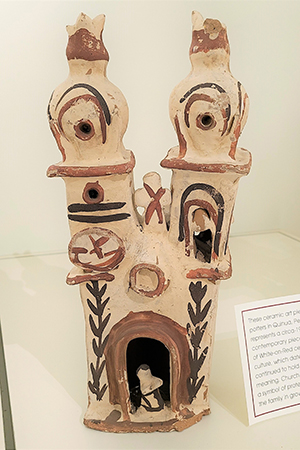Peruvian Roof Ornament

This ceramic roof ornament in the form of a church is from the small town of Quinua in central Peru. Quinua is known for its pottery, with ceramics providing the largest source of income for approximately one quarter of the population today. At the time this piece was made in the mid-20th century, many potters worked only part of the year on their art. They would farm during the rainy season and then make pottery during the dry season between harvest and planting.
Ceramics are often a familial artform in Quinua, passed down from fathers to sons. The pieces are molded by hand from local clay and fired in wood-fed brick ovens. They are then painted with mineral-based paints in white, red, and black. The style of white-on-red ceramic decoration, as seen on this church, has its roots in the Wari culture, which dates from 500-1000 CE.
Although many forms of ceramics are produced in Quinua, church models like this one are the most emblematic shape. Some are simple, like this one, while others are more complex and may be modeled after specific churches like the cathedral in the nearby city of Ayacucho. The miniature churches are meant to be placed on the roofs of houses, and the sculptors create narrow bell towers to accentuate the illusion of height when viewed from the ground. The figures are part of a tradition of ceramic roof ornaments found across southern Peru. The use of churches for these ornaments, however, is most commonly found in Quinua and the nearby town of Huamanga. The churches are placed on the roofs of newly occupied houses to protect against evil spirits. Although they are now produced largely for the tourist market, the churches retain this local purpose as well.
This piece is featured in the virtual exhibit Experiences of Colonialism in Latin America.

